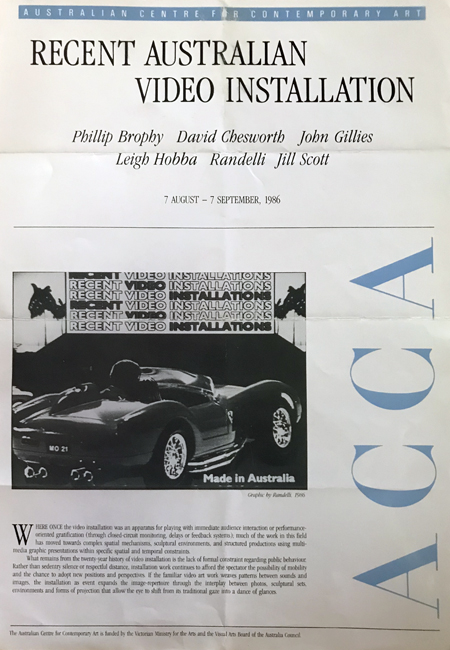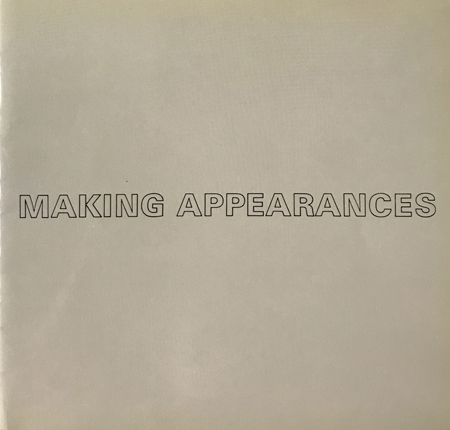Catalogue Essays & Reviews
The audiovisual essay as art practice
published in NECSUS Audiovisual Essays Spring 2015, Amsterdam © 2015
by Cristina Álvarez López and Adrian Martin
(...) Historical perspective is provided by the second selection for this issue, Philip Brophy’s Club Video. This piece began life in 1985 as a video installation arranged across two freestanding monitors and an autonomous stereophonic or quadraphonic sound playback. In this context, the precise fusion of image with music was open to chance fluctuations and surprises. At that time, Brophy produced his work under the collective moniker of → ↑ → (pronounced, approximately, Tsk Tsk Tsk), a multimedia ensemble. More recently, Brophy, as part of his long career as a solo artist, reassembled Club Video into a split-screen DVD with a synchronised soundtrack for theatrical screening. The resulting formation is spectacular in a cinematic way – as a prime example of split-screen juxtaposition – rather than the originally immersive or environmental spectacle of the installation set-up.
Yet ‘cinema’ in Club Video comes in a deliberately degraded, fragmented, and recycled form – with an in-built, cheeky reference to the type of ‘wallpaper video’ projections that were ubiquitously popular in the background of noisy nightclubs in the 1980s, in a mass-media-mad transformation of the type of ‘light and sound’ projections that had been pioneered (sometimes by moonlighting avant-garde artists) for rock concerts since the 1960s. Brophy, pillaging VHS tapes (many recorded from Australian television in the early 1980s) of variable technical quality, distills several canonical Hollywood films (including Stagecoach [John Ford, 1939], Touch of Evil [Orson Welles, 1958], and Psycho [Alfred Hitchcock, 1960]) into their generic and cinematic essence: gestures, movements, types. There is almost a pedagogical slant to it, forecasting one current development in the audiovisual essay: there is at least a semester’s worth of material in its survey of standard, popular American genres (western, musical, gangster, horror, et al.). Narrative is broken down into its identifiable tropes and myth makes way for ideological exposé – along the lines of the 1970s textual film theory that Brophy was steeped in, and which he reformulated anew in the context of his now classic 1987 edited and self-published volume Stuffing: Film: Genre. Cinema – even as apprehended with a cinephile’s passion – is no longer pure or pristine in Club Video; it is derived from television, goes through a video edit, and ends up in a digitised dance.
The musical score for Club Video, composed and assembled by Brophy, is as much a collage as the filmic images (the sources of all samples are listed in the end credits, which reward close study). It, too, provides (as Brophy’s sound work frequently does) an expert ‘scansion’ of tropes and types in 1980s dance music: the beats, glissandos, breaks, and flutters which evoke a particular social world while subtly ‘mutating’ the sonic effect of them all arranged together. (...)
Recent Australian Video Installation
published in Recent Australian Video Installation Australian Centre for Contemporary Art, Melbourne © 1986
by Stephen Goddard
(...) Philip Brophy's Club Video functions equally as an examination ton of narrative patterns in five historically classic film genres. and as an installation devised as a dual-monitor presentation. The re-shaping that occurs is as much a matter of juggling, as highlighting the constituent elements and fundamental characteristics of each genre: thc choreographic environment and startling visual designs of the Busby Berkeley Musical; the push for power by surrogate heroes in the Gangster movie; the sense of location and confrontation in the Western; the subterranean explosive threat of the Youth gangland flick; and the nightmare world of restless suspense in the Horror genre. The endurance and proliferation of these categories in narrative forms indicates the persistence of their cultural mythologies.
The effect of reworking these elements pushes preconceived notions past their familiar resting places. As an installation. the movement, design and rhythm on one monitor is often either mirrored or echoed on the other. At times this is a shot/reaction shot, and on other occasions it is possible to simultaneously view a wide shot next to a close-up or reverse angle. The manipulation of the available material constantly contrasts movement either within the frame or from shot to shot, to develop precise visual juxtapositions.
The strategies and re-arrangements of order, duration, repetition and frequency utilized in Club Video disrupt and displace notions of untouchable singular inevitability and conventional linear continuity. In this respect, the installation privileges an audience that doesn't necessarily recognize the details of the selected narrative, but rather revels in the iconographic marks and the underlying narrative codes in each of the genres. It is, as such, well-suited for screening in a multitude of environments - from a club or disco, to an airport waiting lounge. (...)









